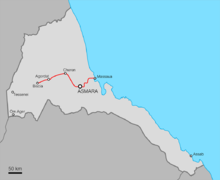Rail transport in Eritrea
The rail transport plays in Eritrea today only a minor role.
Operated railway lines
Massaua – Biscia
See main article Massaua – Biscia railway
The only operating railway line is the Massaua – Biscia line , a narrow-gauge railway with a gauge of 950 mm. Today it can be navigated between the port city of Massaua and Asmara , the capital of Eritrea , was built from 1887 and extended to Biscia until 1941 . The railway in Eritrea is probably the only one in the world that has the complete infrastructure and organization of a state railway , but does not allow a single scheduled train to run.
Hafenbahn Assab
The Ethiopian Petroleum Cooperation established in 1939 in the port of Assab , a port and industrial railway in the track width 950 mm. It may still be in operation.
Disused railway lines
Zula – Kumayli Plain
The Zula – Kumayli Plain railway was built in 1868 during the clashes between British-Indian military units and the Ethiopian army with railway material from India in the broad gauge of 1676 mm. The almost 17 km long railway line was only in operation for a short time during the military campaign.
Mersa Fatma – Colluli
Starting in 1905, a 600 mm track was built from the port of Mersa Fatma to the hinterland, which ultimately ended behind Colluli at 74.5 km . Its main purpose was to remove potash and had to cease operations during the Great Depression in 1929.
Malawiya-Tesseney
In World War II drove the British Army in 1941, branching off from the Sudanese railway Haija junction Sennar the railway Malawiya-Tessenai in the Sudan used Cape gauge to Eritrea before that eventually kilometers west to about 38 of Tesseney enough. However, the gap to the Massaua – Asmara railway line was not closed. After the Italian colonial power had lost the war in the area of their colony against the British army in 1941, the new colonial power dismantled the tracks from Sudan to Tesseney, as they needed the material for their further warfare in North Africa.
operator
In the area that is now part of Eritrea, the following railway operators have been active over time:
- the British military, British Indian Army ;
- the Italian military;
- Compagnia Mineraria Coloniale (CMC)
- Ferrovie Eritree (FE)
- Northern Ethiopian Railway (NER)
- Società Italiana per le Saline Eritree
literature
- Christoph Grimm: Relief goods for the railroad in Eritrea. In: Eisenbahn-Revue International 3/2011, pp. 153–155.
- Neil Robinson: World Rail Atlas and Historical Summary 7 = North, East and Central Africa. o. O. 2009, ISBN 978-954-92184-3-5 , tables 35 and 39.
- Bernd Seiler: Eritrea - Railway between the past and the future. In: LOK Report. Issue 4, pp. 52-58.
Web links
- Website of Ferrovia Eritrea ( Italian )
- Eritrea Railway at Mare
- Pictures on railpictures.net
Individual evidence
- ↑ Grimm: Relief goods for the railroad in Eritrea. P. 153.
- ↑ Neil Robinson: World Rail Atlas and Historical Summary 7. pp. 38 f., Especially note 5.
- ^ Neil Robinson: World Rail Atlas and Historical Summary 7. p. 37.
- ^ Neil Robinson: World Rail Atlas and Historical Summary 7. p. 39, plate 39.
- ^ Neil Robinson: World Rail Atlas and Historical Summary 7. p. 39, also mentions the Sudan Government Railways & Steamers in this context.
- ↑ Neil Robinson: World Rail Atlas and Historical Summary 7. pp. 38 f., Plate 35.
- ^ Neil Robinson: World Rail Atlas and Historical Summary 7. p. 39.

